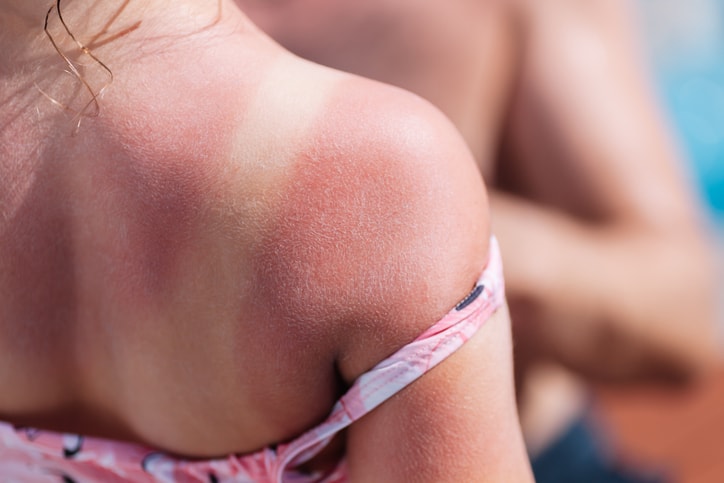The hot July sun is here, and families are taking full advantage of it! As much fun as it is to be enjoying our time outdoors, it is important to remember to take precautions against UV rays, especially for young children. We know that no matter how hard you try, sometimes the sun defeats even the most vigilant of parents and your child may occasionally experience the bane of the summertime sun: the dreaded sunburn.
Alzein Pediatrics is here to help by explaining more about sunburns, how to treat them and when to consider getting medical help for a sunburn. We’ll also remind you to use sunscreen regularly and reapply every two hours and after any water play.
Sunburns are separated into three categories:
- First-degree burns only affect the top layer of skin and are the most common of burns from the sun
- Second-degree burns affect the first two layers of skin and are more likely to blister
- Third-degree burns permanently damage tissue and affect all layers of the skin
Regardless of the degree of burn your child is experiencing, remember what NOT to do:
- Do not apply ointment or butter as this may cause infection
- Do not break blisters that may form
First-Degree Sunburn
Most sunburns fall under this category. You will notice the skin will turn dark pink to light red, be painful to the touch, and may swell. While painful, this burn is considered minor and will heal on its own within two weeks.
Treat a first-degree sunburn by running the burn under cold water or applying a cold compress until the pain subsides. To ease pain, give your child the appropriate dosage of acetaminophen or ibuprofen. You can also apply over-the-counter healing creams containing aloe or a low-dose (0.5%-1%) hydrocortisone cream.
In most cases, a first-degree burn can be treated at home, but call our office immediately if:
- Your child is younger than one year
- The burn covers more than 15% of the body
- Your child is dehydrated; crying without tears, has sunken eyes, and little or no urination
- Your child develops a fever greater than 101° F
- Your child has extreme pain that lasts longer than 48 hours
Second-Degree Sunburn
This burn is more painful. The skin will turn deep red. Because of leaking fluids, the skin will look glossy. It will also blister. You may also notice skin loss in areas with a second-degree burn.
If your child experiences a second-degree burn, immerse the burned area in cold water or apply a cold compress for 15 minutes. Pat the burn dry gently with a clean cloth and apply sterile gauze around the area. If the burn is on the child’s arms or legs, elevate the affected limb as much as possible. Monitor your child for shock symptoms, including cool clammy skin, pale skin, blue or grayish tinges to lips or fingernails, rapid pulse and breathing, and enlarged pupils. If you see these symptoms, visit Urgent Care immediately.
At Urgent Care, your Alzein healthcare provider will examine the burn and ensure the wound is clean and wrapped properly. We’ll discuss pain management, how to change the dressings of the burn daily, and recommend appropriate over-the-counter medicines. These instructions need to be followed closely to prevent infection. Depending upon your child’s immunization status, a tetanus shot may be administered. Treatment may vary depending on the age and general health of your child.
Second-degree burns can take up to two to three weeks to heal. The burned area should be covered and kept away from the sun while the burn is healing. A second-degree burn may cause permanent skin changes; skin may be lighter or darker than the surrounding areas after it is healed.
Third-Degree Burn
Third-degree burns typically are a result of fire or chemical exposure and it is unlikely that sunburn will be this severe. However, in very extreme circumstances, it is possible. if your child’s burn is painless, and the skin appears dry, leathery, or charred with black, or brown spots, call 9-1-1 immediately.
Long-Term Risks for Burns
Long-term risks of getting repeated sunburns in childhood can lead to life-changing and life-threatening complications in adulthood. According to The Skin Cancer Foundation, “even one blistering sunburn in childhood or adolescence more than doubles your chances of developing melanoma later in life.”
Take precautions against the sun to avoid short-term discomfort and long-term health risks. Make it a habit to apply sunscreen every morning and to carry a tube or can with you to reapply every two hours, after swimming, after sprinkler play, and when your child is sweating. Stay in the shade as much as possible, especially with younger children. Make sure kids are wearing wide-brimmed hats and sunglasses. Keep the fun in the summertime by avoiding sunburn altogether.
Questions about sunburn, sunscreen, or any kind of summer precautions? Click here to make an appointment or call 708-424-7600 to speak with your Alzein Pediatrics healthcare professionals. You can also visit Our Evergreen Park, Oak Lawn/95th Street, and Urgent Care locations. We are always happy to help!


